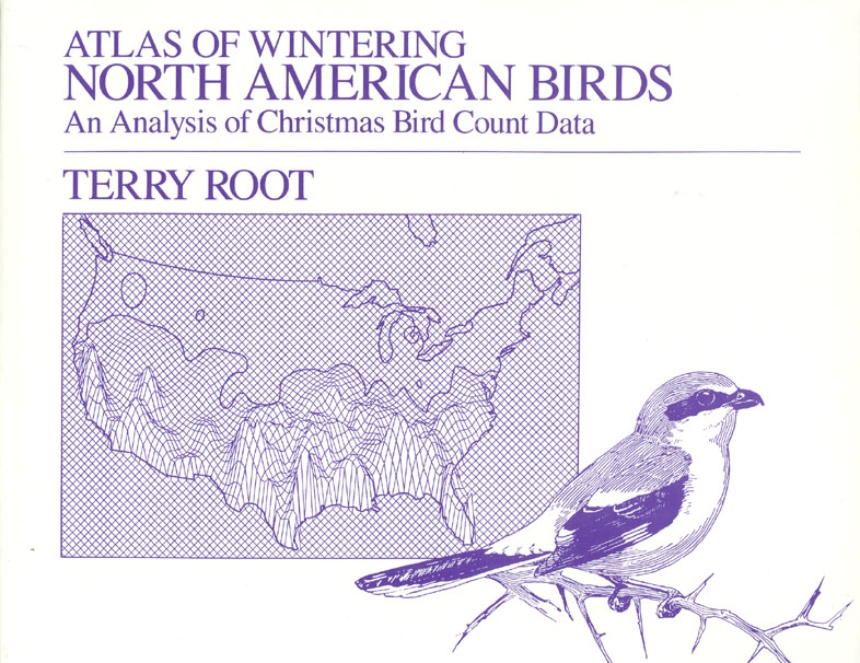Atlas of Wintering North American Birds
An Analysis of Christmas Bird Count Data
The Atlas of Wintering North American Birds represents the effects of thousands of people who have participated in the Christmas Bird Counts, an annual event sponsored since 1900 by the National Audubon Society. Unlike a conventional field guide, the Atlas doesn’t show what birds look like, but rather tells where to find them in the winter months.
Terry Root has used the data from the 1963-72 counts to provide the first large-scale biogeographical account of birds wintering in North America. Using sophisticated computer techniques, Root has translated the data into both traditional contour maps and innovative new maps that stimulate three dimensions. The maps show at a glance that, for example, the Baltimore Oriole winters primarily along the eastern seaboard, with the densest populations in Florida between Tallahassee and Gainesville and in North Carolina from Rocky Mount to the Croatan National Forest.
Terry Root has used the data from the 1963-72 counts to provide the first large-scale biogeographical account of birds wintering in North America. Using sophisticated computer techniques, Root has translated the data into both traditional contour maps and innovative new maps that stimulate three dimensions. The maps show at a glance that, for example, the Baltimore Oriole winters primarily along the eastern seaboard, with the densest populations in Florida between Tallahassee and Gainesville and in North Carolina from Rocky Mount to the Croatan National Forest.
336 pages | 42 line drawings, 620 maps, 11 overlays | 11 x 8-1/2 | © 1989
Biological Sciences: Ecology
Table of Contents
Foreword
Acknowledgments
Introduction
How to Read the Contour Maps
Species Accounts
Gaviidae (Loons)
Podicipeddidae (Grebes)
Procellariidae (Fulmar and Shearwaters)
Pelecanidae (Pelicans)
Sulidae (Gannet)
Phalacrocoracidae (Cormorants)
Anhingidae (Anhinga)
Fregatidae (Frigatebird)
Ardeidae (Bitterns, Herons, and Egrets)
Threskiornithidae (Ibis and Spoonbill)
Ciconiidae (Stork)
Anatidae (Swans, Geese, and Ducks)
Cathartidae (Vultures)
Accipitridae (Osprey, Kite, Eagles, and Hawks)
Falconidae (Caracara and Falcons)
Cracidae (Chachalaca)
Phasianidae (Grouse, Quail, and Allies)
Aramidae (Limpkin)
Rallidae (Rails, Coot, and Allies)
Gruidae (Cranes)
Characdriidae (Plovers)
Haematopodidae (Oystercatchers)
Recurvirostridae (Stilt and Avocet)
Scolopacidae (Sandpipers, Phalaropes, and Allies)
Laridae (Gulls, Terns, and Allies)
Alcidae (Alcids)
Columbidae (Doves)
Cuculidae (Cuckoos, Roadrunner, and Anis)
Tytonidae (Barn-Owl)
Strigidae (Other Owls)
Caprimulgidae (Nightjars)
Apodidae (Swift)
Trochilidae (Hummingbirds)
Alcedinidae (Kingfishers)
Picidae (Woodpeckers)
Tyrannidae (Flycatchers)
Alaudidae (Larks)
Hirundinidae (Swallows)
Corvidae (Jays, Crows, and Allies)
Paridae (Chickadees and Titmice)
Remizidae (Verdin)
Aegithalidae (Bushtit)
Sittidae (Nuthatches)
Certhiidae (Creeper)
Troglodytidae (Wrens)
Cinclidae (Dipper)
Muscicapidae (Kinglets, Gnatcatchers, Thrushes, and Wrentit)
Mimidae (Thrashers)
Motacillidae (Pipits)
Bombycillidae (Waxwings)
Ptilogonatidae (Phainopepla)
Laniidae (Shrikes)
Sturnidae (Starling and Myna)
Vireonidae (Vireos)
Emberizidae (Warblers, Sparrows, Blackbirds, and Allies)
Fringillidae (Finches)
Passeridae (Old World Sparrows)
Appendix A: Species List
Appendix B: Maps with Possible Problems
Literature Cited
Index
Acknowledgments
Introduction
How to Read the Contour Maps
Species Accounts
Gaviidae (Loons)
Podicipeddidae (Grebes)
Procellariidae (Fulmar and Shearwaters)
Pelecanidae (Pelicans)
Sulidae (Gannet)
Phalacrocoracidae (Cormorants)
Anhingidae (Anhinga)
Fregatidae (Frigatebird)
Ardeidae (Bitterns, Herons, and Egrets)
Threskiornithidae (Ibis and Spoonbill)
Ciconiidae (Stork)
Anatidae (Swans, Geese, and Ducks)
Cathartidae (Vultures)
Accipitridae (Osprey, Kite, Eagles, and Hawks)
Falconidae (Caracara and Falcons)
Cracidae (Chachalaca)
Phasianidae (Grouse, Quail, and Allies)
Aramidae (Limpkin)
Rallidae (Rails, Coot, and Allies)
Gruidae (Cranes)
Characdriidae (Plovers)
Haematopodidae (Oystercatchers)
Recurvirostridae (Stilt and Avocet)
Scolopacidae (Sandpipers, Phalaropes, and Allies)
Laridae (Gulls, Terns, and Allies)
Alcidae (Alcids)
Columbidae (Doves)
Cuculidae (Cuckoos, Roadrunner, and Anis)
Tytonidae (Barn-Owl)
Strigidae (Other Owls)
Caprimulgidae (Nightjars)
Apodidae (Swift)
Trochilidae (Hummingbirds)
Alcedinidae (Kingfishers)
Picidae (Woodpeckers)
Tyrannidae (Flycatchers)
Alaudidae (Larks)
Hirundinidae (Swallows)
Corvidae (Jays, Crows, and Allies)
Paridae (Chickadees and Titmice)
Remizidae (Verdin)
Aegithalidae (Bushtit)
Sittidae (Nuthatches)
Certhiidae (Creeper)
Troglodytidae (Wrens)
Cinclidae (Dipper)
Muscicapidae (Kinglets, Gnatcatchers, Thrushes, and Wrentit)
Mimidae (Thrashers)
Motacillidae (Pipits)
Bombycillidae (Waxwings)
Ptilogonatidae (Phainopepla)
Laniidae (Shrikes)
Sturnidae (Starling and Myna)
Vireonidae (Vireos)
Emberizidae (Warblers, Sparrows, Blackbirds, and Allies)
Fringillidae (Finches)
Passeridae (Old World Sparrows)
Appendix A: Species List
Appendix B: Maps with Possible Problems
Literature Cited
Index
